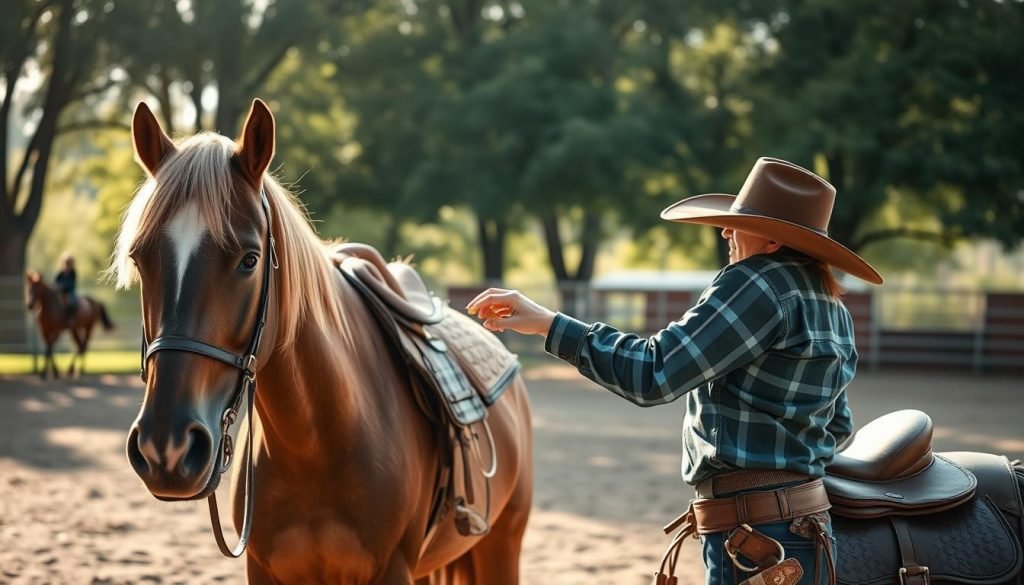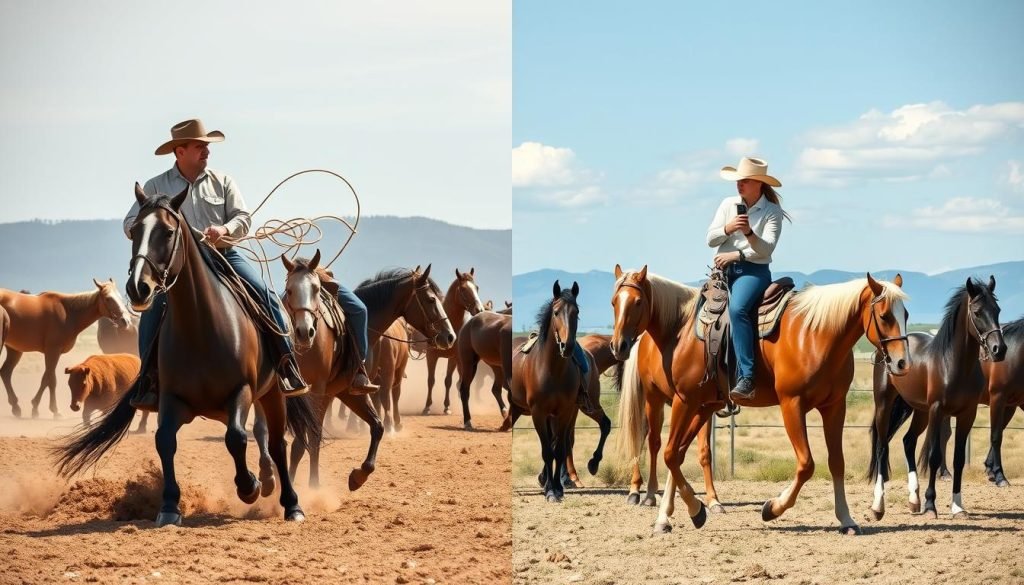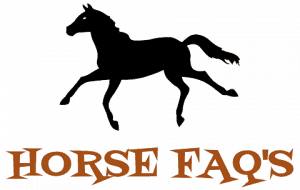Have you ever wondered why some horses seem to excel effortlessly in competitions while others struggle to grasp basic commands? The answer often lies in the consistency in Western horse training. This crucial element establishes a predictable framework that not only fosters equine behavior modification but also builds a profound sense of trust between horse and rider. Understanding the importance of consistency in Western horse training can be the key to unlocking your horse’s full potential. As we navigate through this article, we will explore effective techniques and principles that enhance training success while emphasizing the rewarding journey of building trust with horses.
Key Takeaways
- Consistency establishes a solid foundation for effective training.
- Trust between horse and rider is built through predictable interactions.
- Positive reinforcement encourages long-term behavioral change.
- The role of repetition cannot be underestimated in equine learning.
- Understanding horse psychology is essential for successful training.
- Patience is crucial for navigating training setbacks.
The Role of Consistency in Effective Horse Training
Consistency plays a crucial part in effective horse training, serving as the foundation for a healthy relationship between horse and rider. At places like Circle D Ranch in Norco, horses engage in various activities 3-4 days a week, ensuring they experience predictable routines in tasks such as haltering, leading, and grooming. This structured approach helps horses feel secure and fosters trust-building, an essential aspect for any successful training environment.
Most horse owners recognize the significance of maintaining consistent routines, particularly in feeding and turnout orders. Such practices not only contribute to the well-being of the horse but also facilitate the training process, allowing riders to establish clear guidelines that the horses can understand. Inconsistent signals from handlers can lead to confusion, which often results in a frustrating experience for both parties.
Professional trainers exhibit a high degree of consistency and systematic approaches to handling and riding horses. Their experiences underline the role of consistency in avoiding common pitfalls such as setting unclear boundaries during groundwork sessions. Horses primarily communicate through body language, gestures, and subtle cues. When riders focus mainly on verbal commands, they may miss these important signals, further complicating the training process.
Effective horse training hinges on clear communication and consistent expectations. Poor performance can often be traced back to conflicting signals from riders. By establishing strong leadership that prioritizes consistency, trainers can create an environment where the horse feels understood and secure. This not only enhances their learning capabilities but also solidifies the trust necessary for successful training.
| Training Aspect | Benefits of Consistency | Potential Issues with Inconsistency |
|---|---|---|
| Routines | Builds trust and security | Causes confusion and anxiety |
| Communication | Enhances understanding of cues | Leads to misinterpretations |
| Leadership | Establishes authority and comfort | Creates a lack of direction |
| Training Techniques | Increases learning effectiveness | Results in poor performance |
The Importance of Consistency in Western Horse Training
The role of consistency in Western horse training cannot be overstated. It serves as the backbone of effective training practices, directly influencing two critical areas: building trust with your horse and establishing a predictable environment for learning. When trainers implement consistent methods, horses feel secure, which facilitates a strong bond between them.
Building Trust and Understanding with Your Horse
Trust is a key element in any successful training regimen. Horses learn best when they feel appreciated and understood, creating an environment conducive to growth. The importance of consistency manifests in the way trainers approach each session, which fosters an emotional connection. Consistent commands and cues help horses recognize what is expected, establishing a clear communication channel that leads to a trusting relationship.
Creating a Predictable Training Environment
A predictable environment is essential for effective horse training. When horses experience consistent routines, they can anticipate their trainer’s actions and the session’s flow. This reduces anxiety and promotes better focus, making learning more effective. By maintaining a steady training atmosphere, trainers can minimize stress on the horse, encouraging smoother transitions and enhancing overall performance.
| Aspect | Details |
|---|---|
| Building Trust | Fosters a strong bond through mutual respect. |
| Consistency in Commands | Ensures horses understand expectations and cues. |
| Training Environment | Creates a space where horses feel secure and relaxed. |
| Learning Efficiency | Promotes better focus and less anxiety during training. |
| Emotional Connection | Strengthens the horse-trainer relationship over time. |
Establishing Clear Communication with Your Horse
Effective communication acts as the foundation for successful training and bonding between horse and rider. The relationship can significantly improve by recognizing and interpreting subtle cues alongside maintaining a keen awareness of body language. Clear communication allows trainers to convey their expectations, while understanding a horse’s response enhances the overall training experience.
Understanding Subtle Cues
Horses communicate through various subtle cues that can easily be overlooked by untrained observers. Changes in ear positioning, tail movements, and even facial expressions offer insights into a horse’s emotional state. Observing these signals helps trainers gauge the horse’s comfort level and readiness to engage. By fostering this awareness, trainers can respond appropriately, ensuring a smoother training process and reinforcing clear communication.
The Effect of Body Language on Horse Behavior
Body language plays a pivotal role in horse training. A trainer’s stance, movement, and overall demeanor can influence how a horse perceives commands. For instance, a calm and confident presence typically encourages a similar response from the horse. When verbal and non-verbal communication align, the chance for effective interactions increases. Establishing consistency in body language helps build trust, leading to improved relationships and enhanced performance.
Positive Reinforcement Techniques for Better Results
Positive reinforcement techniques are essential in training horses, as they effectively encourage desired behaviors. By utilizing various methods, trainers can harness the power of rewards to foster a healthy learning environment. This section explores how to implement positive reinforcement in training sessions, providing insights into different forms of rewards.
Encouraging Desired Behaviors
Implementing positive reinforcement techniques allows trainers to encourage desired behaviors by associating them with attractive outcomes. For instance, when a horse successfully follows a command, offering verbal praise or a treat reinforces this behavior. This approach not only motivates the horse but also strengthens the bond between horse and trainer. A well-executed reinforcement strategy can lead to faster learning and better retention of skills, as horses tend to repeat actions that are positively reinforced.
Different Forms of Rewards
There are various forms of rewards that trainers can incorporate into their techniques to maximize effectiveness. Common rewards include:
- Verbal Praise: Simple words of encouragement can boost a horse’s confidence.
- Physical Affection: Petting or gentle strokes convey approval and create a comforting atmosphere.
- Treats: Offering food rewards serves as a strong motivating factor for horses.
- Marker Signals: Sounds or clicks can serve as cues, marking a desired behavior and signaling an impending reward.
Properly applied forms of rewards can significantly lower training stress. This method, when executed with consideration for the horse’s emotional state and individual needs, yields the most beneficial results in training. Proper supervision and attention to the horse’s response are crucial, as poorly implemented positive reinforcement might induce frustration or unwanted behaviors. Ultimately, trainers should aim to create an engaging and positive learning journey for their equine companions.

Creating Training Routines for Consistency
Establishing structured training routines is vital for achieving consistency in horse training. Regular repetition of exercises plays a crucial role in reinforcing behavior and making it instinctual for the horse. This section explores the significance of creating effective training routines through systematic approaches and scheduled daily training sessions.
Importance of Repetition in Horse Training
Repetition serves as a cornerstone in developing strong training routines. Consistent practice enables horses to learn and remember specific commands and maneuvers. Research indicates that a well-designed routine, involving a sequence of drills, enhances retention and effectiveness. For instance, integrating 12 basic Ground Drills in a specific order allows for optimal learning outcomes. Each maneuver should be taught in clear, small steps to ensure that horses grasp the intended goals efficiently.
Structuring Daily Training Sessions
Daily training sessions should follow a well-defined structure to maintain momentum and progress. Creating a personal “Pilot’s Checklist” can help trainers stay organized and ensure that all essential drills are covered. Emphasizing a sequence and rational order to these drills sets up the horse for greater success. The principles of being Clean, Clear, Concise, Consistent, and Committed in all communications are critical for effective training.
A study from Cornell University revealed that ponies trained once a week required fewer sessions to learn tasks compared to those trained more frequently. This finding suggests that a focused, less frequent approach can sometimes yield better results, underscoring the importance of quality over quantity in training routines.
Incorporating repetition and a logical progression in daily training sessions not only facilitates learning but also allows trainers to assess progress effectively. This strategic approach can minimize confusion and resistance while fostering a deeper bond between trainer and horse.
| Type of Drill | Recommended Sequence | Focus Area |
|---|---|---|
| Basic Ground Drills | 1-12 | Foundation Behaviors |
| Basic Saddle Drills | 1-12 | Riding Skills |
| Pilot’s Checklist | N/A | Essential Drills |
Patience in Training: A Cornerstone of Consistency
Patience plays an essential role in successful horse training. A progressive training approach allows trainers to tailor their techniques based on each horse’s unique learning speed. Understanding and adapting to these individual differences foster an environment where horses can thrive. Such an approach not only helps in building trust but also ensures that each training session contributes positively to the horse’s overall learning experience.
The Value of a Progressive Training Approach
A progressive training approach emphasizes gradual learning. This method includes clear structures in training sessions, allowing for incremental improvements over time. Regular, short training exercises surpass infrequent, longer sessions in effectiveness. Techniques like groundwork, desensitization, and leading are fundamental, ensuring horses receive comprehensive foundational knowledge. By promoting patience in training, trainers can recognize the small victories that lead to long-term success, creating a comfortable atmosphere for the horse to engage.
Handling Setbacks with Understanding
Setbacks are an inevitable part of the training journey. Maintaining a patient attitude is crucial in handling these challenges, as it prevents resistance and anxiety in horses. When trainers approach setbacks with understanding, they can help rebuild confidence and trust, making it easier for horses to progress. This empathetic approach not only strengthens the horse-rider relationship but also aligns the training process with the horse’s natural learning capabilities.
Understanding Horse Psychology for Effective Training
Equipping oneself with a solid understanding of horse psychology can substantially enhance the efficacy of training sessions. Recognizing how stress impacts a horse’s ability to learn is fundamental. When a horse experiences stress, it can hinder their cognitive functions, resulting in ineffective learning. Identifying individual learning styles paves the way for personalized training approaches that promote better understanding and rapport between the horse and rider.
The Impact of Stress on Learning
Horse psychology reveals that stress significantly affects learning capabilities. When horses are faced with stressful environments, their focus may shift, making it challenging for them to absorb new information. Training methods should aim to minimize this stress impact. Techniques may include creating a calm environment, using positive reinforcement, and gradually exposing the horse to new experiences. By addressing stressors proactively, you encourage a more receptive attitude towards learning.
Recognizing Individual Learning Styles
Every horse possesses unique learning styles, which can determine how they respond to various training techniques. Some may thrive on repetitive exercises, while others might engage better through varied activities. Understanding these differences allows trainers to tailor sessions effectively, fostering greater enjoyment and improvement. Implementing approaches that resonate with an individual horse not only aids in retention of skills but also strengthens the bond between horse and trainer. The key lies in observing and adapting to each horse’s preferences, ultimately leading to successful training outcomes.
Common Horse Training Methods and Their Consistency
Exploring various horse training methods reveals how consistency can shape outcomes. Each approach holds unique characteristics and effectiveness, affecting horses differently based on their individual personalities.
Comparing Different Approaches: What Works Best?
The landscape of horse training is rich with diverse horse training methods, ranging from traditional Vaquero techniques to contemporary natural horsemanship. Traditional methods often emphasized harsher techniques, particularly in producing a bridle horse. In contrast, modern programs frequently aim for softer and more relaxed horses. The comparison of approaches highlights several critical aspects:
- Speed vs. patience: Rushed training programs, common in show horses, can overlook the importance of gradual learning.
- Behavior patterns: Some trainers incorporate natural behaviors to nurture a harmonious relationship between horse and rider.
- Technique adaptation: Variations in individual skill levels among trainers significantly impact outcomes.
Integrating Various Methods for Holistic Training
Achieving a comprehensive holistic training program involves integrating multiple approaches. The idea of combining traditional techniques and newer methods can yield effective results. Programs that focus on round penning and gentle games often produce relaxed horses while emphasizing communication and partnership. Factors to consider include:
- Understanding each horse’s unique learning style and personality.
- Utilizing patient techniques that emphasize consistency over quick fixes, avoiding the pitfalls of harsh discipline.
- Prioritizing long-term relationships over short-term wins in competitions.

This strategic blending allows trainers to cater to individual horse needs, fostering an environment that respects their natural tendencies while maximizing their potential.
Building Trust with Horses Through Consistency
Establishing a firm foundation of trust between horse and rider is essential for effective training. Consistency plays a key role in this process, as it helps foster a positive relationship that can yield long-term benefits for both parties. Understanding the intricacies of horse behavior allows riders to communicate effectively, thus reinforcing trust over time.
Strategies to Foster a Positive Relationship
Several strategies can enhance the bond with your horse, making consistency a central theme. Key approaches include:
- Clear Communication: Use subtle cues and maintain a calm demeanor to signal intentions.
- Positive Reinforcement: Reward desired behaviors immediately, reinforcing the connection and trust.
- Reliability in Actions: Consistent training patterns instill a sense of security in horses, encouraging them to respond positively.
- Understanding Behavior: Recognize individual learning styles and adapt training methods accordingly.
Long-term Benefits of Trust in Training
Building trust has significant long-term benefits that transform the training experience. A trusting relationship leads to:
- Enhanced Performance: Horses develop confidence, improving their ability to perform tasks effectively.
- Smoother Cooperation: Trust facilitates seamless transitions between gaits and changes in direction.
- Stronger Bonds: A positive relationship encourages lifelong partnerships, enhancing enjoyment for both horse and rider.
Conclusion
In summarizing the key points on consistency discussed throughout this article, it becomes evident that adopting a structured and informed approach is crucial for successful training in Western horsemanship. Riders are encouraged to utilize specific equipment, such as saddles and bridles, that enable effective communication with their horses. By emphasizing proper balance and effective riding style, trainers can enhance safety and ride efficiency.
A solid understanding of horse behavior, along with consistent body language and cues, fosters a deeper trust between horse and rider, leading to long-term relationships built on respect. Transitioning training techniques, whether from Western to English riding or exploring disciplines like western pleasure, benefits from consistency in posture, technique, and handling. For more in-depth resources about different Western horse breeds and effective training methodologies, you can check out this comprehensive guide on Western horse training.
Ultimately, the guiding principle of consistency serves as the foundation for achieving training goals and nurturing equine partners. Successful training hinges not only on the techniques used but also on the commitment to maintain a predictable and encouraging environment for horses.
FAQ
Why is consistency important in Western horse training?
Consistency is the fundamental element in building trust between horse and rider. It enhances the effectiveness of training techniques and creates a predictable environment that reduces stress, allowing horses to learn more effectively.
How can I build trust with my horse?
Building trust involves using consistent signals, maintaining reliable training patterns, and understanding your horse’s behavior. The more a horse feels understood and appreciated, the stronger the bond will be, leading to improved performance.
What role does clear communication play in horse training?
Effective communication involves understanding subtle cues and body language. Consistent body language reinforces verbal commands, allowing for a deeper connection and better understanding between horse and rider.
What are some positive reinforcement techniques I can use?
Positive reinforcement techniques include verbal praise, physical affection, and treats. These methods encourage desired behaviors and help form a strong, trust-based relationship between the horse and the trainer.
How do I create structured training routines?
Structured training routines involve regular repetition of exercises with clear objectives. Gradually increasing complexity helps the horse learn instinctively and allows trainers to evaluate progress effectively.
Why is patience important in horse training?
Patience is crucial as it allows trainers to recognize individual learning speeds and adjust techniques accordingly. A patient approach helps in effectively handling setbacks, further cultivating the trust and confidence in the horse-rider relationship.
How does understanding horse psychology improve training?
Understanding horse psychology is vital as it allows trainers to recognize stress levels and learning styles. This knowledge enables customization of training sessions, fostering a more supportive environment conducive to growth and learning.
What should I know about different horse training methods?
Familiarizing yourself with various horse training methods allows for a comprehensive comparison, helping identify which approaches yield the best results. Integrating different techniques can create a holistic training program tailored to your horse’s unique personality and learning style.
How can I foster a positive relationship with my horse?
Fostering a positive relationship involves employing strategies such as consistent training, understanding behavior, and building trust over time. This encourages a cooperative training environment that leads to lifelong partnerships and enhanced performance outcomes.
